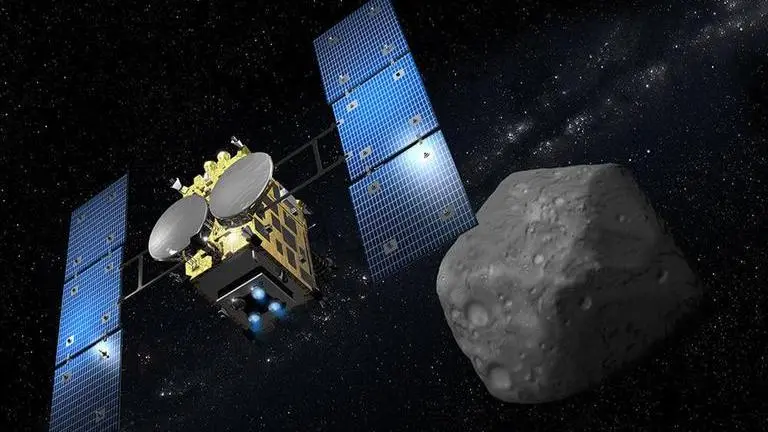Updated 23 July 2020 at 23:07 IST
Arriving December this year, Japan's asteroid probe Hayabusa2 to open knowledge trove
Having collected samples from the asteroid Ryugu last year, Japan’s Hayabusa2 spacecraft is just months away from returning them to Earth.
- Science News
- 3 min read

Having collected samples from the asteroid Ryugu last year, Japan’s Hayabusa2 spacecraft is just months away from returning them to Earth. The samples collected would allow scientists to understand how celestial bodies came to be as they contain material that likely dates back to the dawn of the solar system, 4.6 billion years ago. Scientists will search its samples for signs of hydrated minerals, organic material, and other building blocks of biology.
On July 14, the Japanese Aerospace Exploration Agency (JAXA) and the Australian Space Agency announced the landing date for the samples on December 6, 2020. The sample capsule is planned to land in Woomera, South Australia, and the Agency and JAXA are working towards the planned safe re-entry and recovery of the capsule containing the asteroid samples.
The Hayabusa2 project is considering an extended mission after returning the capsule to Earth. Plans have been narrowed down to 2 possible candidate targets: asteroids 2001 AV43 or 1998 KY26. Both are small & fast spinning objects, which is a type that has not yet been explored. pic.twitter.com/OYpQAyy7ob
— HAYABUSA2@JAXA (@haya2e_jaxa) July 22, 2020
Hayabusa2 was launched in 2014 and arrived at Ryugu in June 2018. In April 2019, the spacecraft fired an impactor into Ryugu from a distance, forming a small crater. Then it swooped down three months later to grab material ejected by the impact. Last November, Hayabusa2 finally left its orbit around the asteroid and began its one-year journey home.
This sequence of images shows the ejecta thrown out of the artificial crater. Images were taken 185s before the impact and 3s, 5s, 36s, 100s, 192s, 396s and 489s after the SCI collision. The right image is an enlargement of the left. (📷 JAXA, Kobe University and collaborators.) pic.twitter.com/GFtFCDf0bg
— HAYABUSA2@JAXA (@haya2e_jaxa) March 20, 2020
Advertisement
According to a report, when Hayabusa2 flies by Earth in December, it will drop off the sample capsule, which must endure a fiery re-entry in our atmosphere from the harsh vacuum of space before parachuting safely to the ground. The spacecraft will head back into space, on an extended mission to one of two possible additional asteroids.
Advertisement
On the ground, a team of about 10 JAXA scientists will await the capsule’s arrival and will rely on its radio beacon, as well as drone-based reconnaissance, to locate its precise touchdown site. The scientists’ aim will be to find the capsule within 100 hours of landing.
Following this early analysis, roughly a day after the capsule’s return to Earth, JAXA will fly the samples to Japan. There, in a clean room, the capsule containers will be opened for the first time. A portion of the samples will immediately be set aside and stored for future generations to study, ideally with more advanced equipment than is available today. The remainder will be transferred to a chamber filled with pure, inert nitrogen gas.
Hayabusa2’s predecessor, Hayabusa, also used the Woomera landing site when it returned a capsule containing about a millionth of a gram of dust from the asteroid Itokawa in 2010. That mission had been planned to retrieve far more, but it was hindered by multiple mishaps in deep space. Hayabusa2’s haul from Itokawa should be larger—up to a gram of material.
(Image credit: hayabusa2.jaxa.jp)
Published By : Digital Desk
Published On: 23 July 2020 at 23:07 IST
